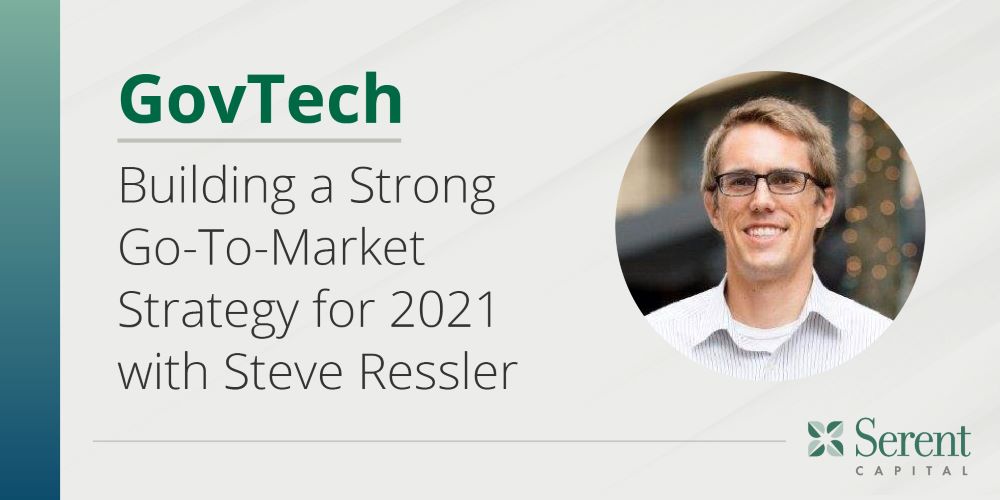The government technology market offers remarkable opportunities for founders in 2021. With public agencies increasingly adopting cloud technologies, entrepreneurs have the tools to develop solutions that help government buyers get their work done in smarter, more efficient ways.
We wanted to explore how GovTech entrepreneurs can develop a go-to-market strategy that enables them to thrive in 2021, so we sat down with a leader who knows the intricacies of the market well. Steve Ressler is a serial entrepreneur and has been part of three successful GovTech company exits, including Founder of GovLoop, which was acquired by GovDelivery in September 2009, as CMO of GovDelivery, which was acquired by Granicus in October 2016, and most recently as President of Callyo, which was acquired by Motorola Solutions in August 2020. We focused on lessons from Steve’s successful exits, including focusing on customer needs, understanding current trends in GovTech, and developing high-value relationships.
Here are five approaches that GovTech founders and entrepreneurs can use to build a strong go-to-market strategy in 2021.
1. Know Your Ideal Customers
When you’re building your go-to-market strategy, the most essential building block is deeply understanding your target customers. Clearly defining your ideal buyers enables you to prioritize how your sales and marketing team spends their time, and ensure that they focus on your best prospects.
Consider questions like:
- What level of government are you selling to — city, county, special districts, state, federal?
- What population size are your ideal customers serving – <100k, 100K-500K, 500K -1MM,1MM+?
- What department are you selling to – IT, HR, City Managers, Budget, etc.
- What’s the size of the customer’s department? How many employees?
- Where are your best customers located geographically?
- What’s the right deal size for my company?
- What’s the right speed to close a deal for my company?
As you narrow down your target audience, one helpful approach is to look at the competitive landscape. Focusing on niches that are neglected by your competitors makes it much easier to own a market segment and close more sales. “Suppose your main competitors are focusing on populations between 500,000 and 10 million,” Steve suggests. “You may want to say, hey, we’ll focus on 100K to 500K. Since the deal size is too small for my competitor, I’m going to focus there [and build a scalable, efficient go-to-market motion tackling that segment].”
“People are starting to look at things that they’re used to in their personal lives and expecting to have that in their work lives, too,” Steve observes. “And that technology can be built, especially on these large players like Amazon and Google that have a lot of APIs to build on. That’s a really exciting opportunity.”
2. Lean Into Current Trends in GovTech
Over the last decade, GovTech has moved increasingly to cloud-first solutions. Top cloud providers like Amazon Web Services and Microsoft have made enormous strides in security and compliance, accelerating the transition to cloud-based technologies and facilitating adoption of cloud-based platforms and applications.
In 2020, cloud-first technologies have become the default, leading people to look for more efficient ways to automate workflows — both in government and everyday life. For instance, now that our smartphones have automatic transcription, we now look for the same capabilities in the recording software we use at work. “People are starting to look at things that they’re used to in their personal lives and expecting to have that in their work lives, too,” Steve observes. “And that technology can be built, especially on these large players like Amazon and Google that have a lot of APIs to build on. That’s a really exciting opportunity.”
The foundation for these types of innovation in GovTech will continue to be state and local government budgets. “There’s always going to be budget constraints in government. I think budgets might get a little bit tighter over time, and that will put more pressure on unlocking new revenue opportunities too. State and local government doesn’t always think of new things they can do to generate revenue, but that’s where the opportunity will be in the future – whether it’s permitting or regulatory or compliance.”
”For example, if you are a twenty-person company and your potential partner is a hundred employees, you can still do things together,” Steve says. “But if you have twenty employees and they have fifty thousand employees, they will likely be slowed down by internal decision making. They’re just going to naturally move at a slower pace and your interests may not align.”
3. Cultivate High-Value Channel Partner Relationships
Building channel relationships can be critical for reaching customers — as long as you do it in the right way. Many founders make the mistake of spreading themselves too thin, connecting with lots of potential partners but ultimately failing to drive new sales for the business.
While developing a large network of connections with leaders in your space makes sense, focus your time and attention on the relationships that will grow your business. A simple litmus test is to ask yourself whether a potential partner’s priorities align with yours. If focusing on your space isn’t important to a potential partner, they likely won’t be a great fit.
Likewise, consider the size of a potential partner. Steve advises looking for partners who are close to you in the growth stage of their business, but one or two steps ahead. ”For example, if you are a twenty-person company and your potential partner is a hundred employees, you can still do things together,” Steve says. “But if you have twenty employees and they have fifty thousand employees, they will likely be slowed down by internal decision making. They’re just going to naturally move at a slower pace and your interests may not align.”
4. Deliver Informative Content
Case studies, white paper, webinars, and other pieces of in-depth content can be a great way to reach more customers. Government buyers are especially interested in learning about best practices and what’s working for other agencies, so high-value, tactical content can be a highly effective way to reach new customers.
Creating content that hits the right tone is key, Steve advises: great content educates the reader without talking down to them. Present yourself as a trusted partner, showing how you’ve helped other agencies solve the exact same problem — and how you can work side by side with your prospect to help them get better outcomes, too.
“Telling someone their old technology is bad, and we’re going to replace it — that just usually doesn’t work,” Steve cautions. “There has to be a reason why they have to do it. And then you can pivot to talking about the new functionality.”
5. Overcome Barriers to Adoption
Resistance is a natural part of the buying process — and getting to yes looks different for different GovTech companies.
If you’re addressing a problem where no current solution exists, your path to adoption may be considerably easier. For example, ArchiveSocial developed a platform to help government entities archive all their social media while remaining compliant with public records laws, solving a common problem for which customers had no viable solution. “I really like those businesses where there’s a new problem because of compliance or new technology, and folks are fitting in,” Steve notes.
Smoothing the path to adoption may be harder if your platform replaces an existing solution. In these cases, research on your ideal customers is key. Ask questions like these:
- When is the end of the life cycle for the existing platform, and are any other platforms tied to it?
- Is there federal funding that can support a transition to a new platform?
- Are there new federal or state reporting requirements?
“Telling someone their old technology is bad, and we’re going to replace it — that just usually doesn’t work,” Steve cautions. “There has to be a reason why they have to do it. And then you can pivot to talking about the new functionality.”
GovTech offers extraordinary opportunities to founders who build a strong go-to-market strategy.
- Know who your ideal customer is, and concentrate your marketing efforts on prospects who fit that profile.
- Build solutions that align with current industry trends. Don’t spread yourself too thin, and cultivate deep relationships with potential channel partners.
- Develop in-depth, tactical content and create a plan to address buying objections.
- Master these fundamentals, and you’ll attract a steady stream of new customers and grow your business quickly in 2021.
Here at Serent, we hope to equip GovTech leaders with the strategies and resources to ensure their customers’ success — and have a transformative impact on the GovTech industry.

